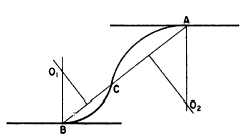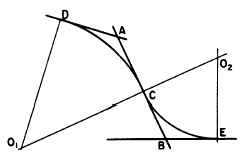|
COMPOUND CURVES A curve that is made up of a series of successive
tangent circular arcs is called a compound
curve. In figure 4-40 the problem is to
construct a compound curve passing through given
points A, B, C, D, and E. First, connect the
points by straight lines. The straight line between
each pair of points constitutes the chord of
the arc through the points.
Erect a perpendicular bisector from AB. Select an
appropriate point 01 on
the bisector as a center, and draw
the arc AB. From 01,
draw the radius 01B.
From BC, erect a perpendicular bisector.
The point of intersection 02 between this
bisector and the radius 01B is the center for
the arc BC. Draw the radius 02C, and erect
a perpendicular bisector from CD. The point
of intersection 03 of this bisector and the
extension of 02C is the center for the arc
CD.
To continue the curve from D to E, you
must reverse the direction of
curvature. Draw the radius 03D,
and erect a perpendicular bisector from DE on
the opposite side of the curve from those previously
erected. The point of intersection of this
bisector and the extension of 03D is the center of
the arc DE.
REVERSE, OR OGEE, CURVE
A reverse, or ogee, curve is composed of two consecutive
tangent circular arcs that curve in opposite
directions,
Figure 4-41 shows a method of connecting two parallel
lines by a reverse curve tangent to the lines.
The problem is to construct a reverse curve tangent
to the upper line at A and to the lower line
at B.
Connect A and B by a straight line AB. Select on
AB point C where you want to have the reverse curve
change direction. Erect perpendicular bisectors
from BC and CA, and erect perpendiculars from
B and A. The points of inter-section between
the perpendiculars (01 and 02) are
the centers for the arcs BC and CA.
Figure 4-42 shows a method of constructing a
reverse curve tangent to three intersecting straight
lines. The problem is to draw a reverse

Figure 4-41.Reverse curve connecting and tangent to two
parallel
lines.

Figure 4-42.Reverse curve tangent to three intersecting straight
lines.
curve tangent to the three lines that intersect at points
A and B. Select on AB point C where you want
the reverse curve to change direction. Lay off
from A a distance equal to AC to establish point
D. Erect a perpendicular from D and another
from C. The point of intersection of these perpendiculars
(01) is the center of the arc DC.
Lay off from B a distance equal to CB to
establish point E. Erect a perpendicular from E,
and extend 01C to intersect it. The point of
intersection (02) is the center of the arc
CE.
|







